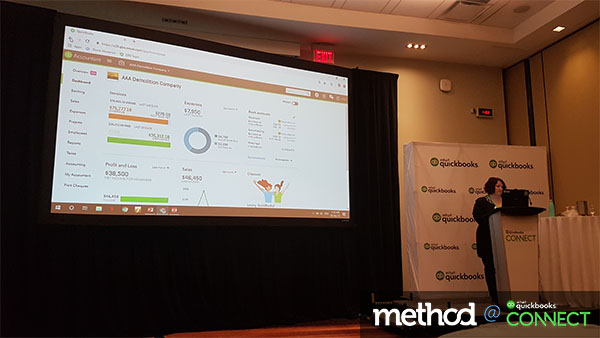There are a million different strategies for succeeding as an entrepreneur. In fact, only one thing holds universally true — there’s no set roadmap for building something unique.
That being said, it never hurts to take some advice from someone who has been there, done that. At QuickBooks Connect, 5Crowd founder Bram Warshafsky shared his top five tips for building a successful business.
1. Fail forward
Failing happens. It doesn’t have to define who you are or what your business is.
Warshafsky shared a story of taking on a project for a client in the early stages of his business. Although he completed the project, he wound up losing a lot of money on it. It’s a disheartening experience that many entrepreneurs can relate to — when you put your time and effort into something that turns out to be unsustainable.
Meanwhile, the project itself turned out so well that the client asked Warshafsky to take on additional work. Warshafsky turned the offer down, but the experience didn’t end his business. Instead, working with this “founding customer” taught him which types of projects he shouldn’t pursue. This led him toward better ways of marketing his business and skills.
It’s natural to want to be perfect when you try something new. But in entrepreneurship, “good enough” beats perfect — because “good enough” keeps you moving forward. Said Warshafsky: “If you ever find yourself whiteboarding something to death in your office, just get out and take action.” When it comes to making concrete progress, trial and error is more productive than strategic thinking.
Ultimately, the best thing you can do while getting your business off the ground is to embrace those small failures. Warshafsky recalled how he made a thousand small pivots in the early stages of his business. Those pivots didn’t stop him in his tracks; they helped him find the right direction. And in the end, that’s the best way to learn the ins and outs of your industry and identify where you fit in.
2. Listen to the market
In order to build a successful business, you need to fulfill your customers’ needs. But in order to get to that stage, you need to understand what those needs are.
Warshafsky described how when he first started out, he tried a lot of different pitches to explain what his company did. But eventually, he realized that his potential clients didn’t care what he did. They cared about what he could do for them.
As a result, Warshafsky stopped announcing what he did and started asking his clients what their problems were. From there, he could simply showcase how he would solve those problems. “The people who close the most deals do the most listening,” he noted.
By listening to what your customer needs before jumping in with a sales pitch, you can identify what type of selling will resonate with them. There are three different levels of selling:
- Level 1: Solving a technical problem
- Level 2: Solving a business problem
- Level 3: Solving an emotional problem
Not surprisingly, emotional sales are the most powerful. Warshafsky recommends looking at your product or service not just in terms of the benefit it offers, but also how that benefit will benefit your customer. “A good question to ask when you look over your sales material is ‘so what?’ This helps you speak to your customers in a more emotional way.”
Your business wouldn’t exist without your customers. So as you make decisions, remember: It’s not about you. It’s about them.
3. Invest in your team
As an entrepreneur, it’s important to invest time and money in developing your team. Whether that team consists of freelancers, remote staff, or in-house employees, the people who work with your company directly contribute to its success.
In a small business, building a strong company culture is hugely beneficial. Not only does it lead to higher employee retention (saving you time and money on recruitment and training), but it also gives employees a stronger connection to your company’s mission.
Investing in company culture can make some business owners uneasy. After all, it’s difficult to measure the ROI of employee morale — but it’s easy to see the financial impact of ordering T-shirts and hosting events. However, it’s important to remember that these investments will pay off in the long run.
“It’s the kind of ROI that doesn’t manifest clearly, but I promise you it’s there,” Warshafsky explained.
In Warshafsky’s case, his freelancers are spread out all over the world — so he got on a plane and spent time with people in different countries to really understand how they lived and worked. Certainly, not every investment in your team needs to be on this level. But if you’ve already put effort into attracting great talent to your business, you might as well put effort into keeping them there.
4. Know your numbers
Revenue is vanity. Profit is sanity. Cash flow is reality.
When Warshafsky first struck out on his own, he had only ever worked for large companies and didn’t know the first thing about cash flow: “It turns out that’s really important in small businesses.”
Because he didn’t fully understand how the revenue cycle in his company should work, he started hoarding money. He was afraid to launch ideas or reinvest in the business, which can completely stifle growth.
The situation got better once he brought in an expert to build a cash flow model. Being able to see several months’ worth of cash flow projections allowed him to become more comfortable with making decisions and spending money. Furthermore, by looking closely at the data, he could see what type of work was most profitable and could allocate funds appropriately.
In order to set your business up for future growth, you need to understand how it’s performing today. This allows you to reinvest strategically. Warshafsky noted that it’s important to know how you would spend your next dollar — even if you don’t have that dollar yet.
5. It’s all about growth
Warshafsky’s final piece of advice for aspiring entrepreneurs was that growth is everything: “It turns out that when you grow really fast, nothing else matters.” You can make a few mistakes, but as long as you’re still growing, those mistakes won’t be dealbreakers.
In Warshafsky’s opinion, it’s best to use a combination of methods to grow your business. He offered the analogy of using seeds, nets, or spears to obtain food. “They’re all good ways to eat, but often entrepreneurs just focus on one of these.”
When you plant a seed, you can never be sure if it’s going to sprout. For an entrepreneur, planting seeds might involve networking, attending conferences, and using social media. Sure, some of these activities might blossom into business opportunities — but it’s difficult to tell which ones.
Building a net involves doing something to capture the interest of potential buyers. Not everyone will get close to the net, but a few people may just fall in. In the case of a business owner, writing blog posts or publishing white papers are great strategies to attract new leads.
Throwing spears is the most intentional method of pursuing new opportunities. You might ask a colleague to connect you with someone from their network or find other ways to gain a direct introduction to a highly sought-after client. Warshafsky believes that this is one of the biggest benefits of social media: “There’s no excuse anymore — if you want to meet someone, you can meet them. You can buzz anyone’s phone and I think that’s a really cool thing.”
Conclusion
Every entrepreneur will have their own definition of success and their own timeline for achieving it. Regardless of your goals, it’s important to be persistent and embrace new challenges without fear of failure. And above all, remember why you started your own business in the first place. As Warshafsky said, “Growth should be fun — so have fun!”
Want more #QBConnect content? Check out our full coverage of QuickBooks Connect Toronto 2018!






